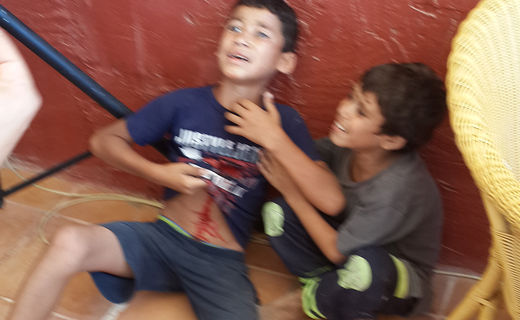
He starts with this: "It is not unusual for militants to launch rockets from sites near my hotel."
So had rockets been launched from the spot where the children were killed? Here's the account of veteran Guardian/Observer correspondent Peter Beaumont:
The building that was hit was just a shipping container next to where one of the kids' father keeps his boat and stores fishing nets. The kids were just playing hide and seek there. They shoot missiles (against Israel) from this neighborhood but none from that location.So how is Booth's introduction relevant in any way to the story? Yes, militants have fired rockets from the neighbourhood (after all, from where else but "neighbourhoods" are they likely to fire rockets in one of the most densely populated places on earth). But, as Beaumont points out, they were not being fired from the area that was attacked by Israel.
Israel is supposedly using precision missiles. So this was deliberate targeting of that area, an open area from which no rockets had been fired and where children regularly play. If Booth believes that rockets fired from the general area somehow justify Israel's missile strikes on the children (and if not, why mention it?), then why the hell is he staying in the al-Deira hotel, which is presumably as likely to be hit as the harbour where the children play?
There is also something unpleasant in his style of writing here. Note this line as the injured children are brought to his hotel.
Two young terrified kids were bleeding and injured, and they were quickly bandaged on the floor of the terrace, where guests usually eat skewers of grilled chicken, suck on water pipes and watch the sun go down.That incidental reference to the chicken and water pipes is added for colour. It's a journalistic technique we use when there's not much happening and you want to set a scene to draw the reader into the story. But here it's entirely unnecessary. The action - the bleeding children and the dead bodies nearby - are what will draw the reader in, as any rookie journalist would know. So when I see Booth pausing from his description to talk about how the guests entertain themselves in the evenings, I sense - both as a journalist and a reader - that his attention is not fully on the events at hand.
I'd like to believe this is his way of responding to the shock of the events he's just witnessed. But I suspect something else is at work here, something revealing about the business of journalism.
Most of the time, we write not for ourselves or our readers but for our editors - in short to keep our jobs. Here Booth was called on to stop being the careerist and connect with his humanity. That, rare though it is in journalism, was what the moment required: to see, really see the desperate, terrified little boys in front of him. Instead, all he could think about was technique and what his editors might want.
Jonathan Cook, based in Nazareth, Israel is a winner of the Martha Gellhorn Special Prize for Journalism. His latest books are Israel and the Clash of Civilisations: Iraq, Iran and the Plan to Remake the Middle East (Pluto Press) and Disappearing Palestine: Israel's Experiments in Human Despair (Zed Books)



Reader Comments
to our Newsletter